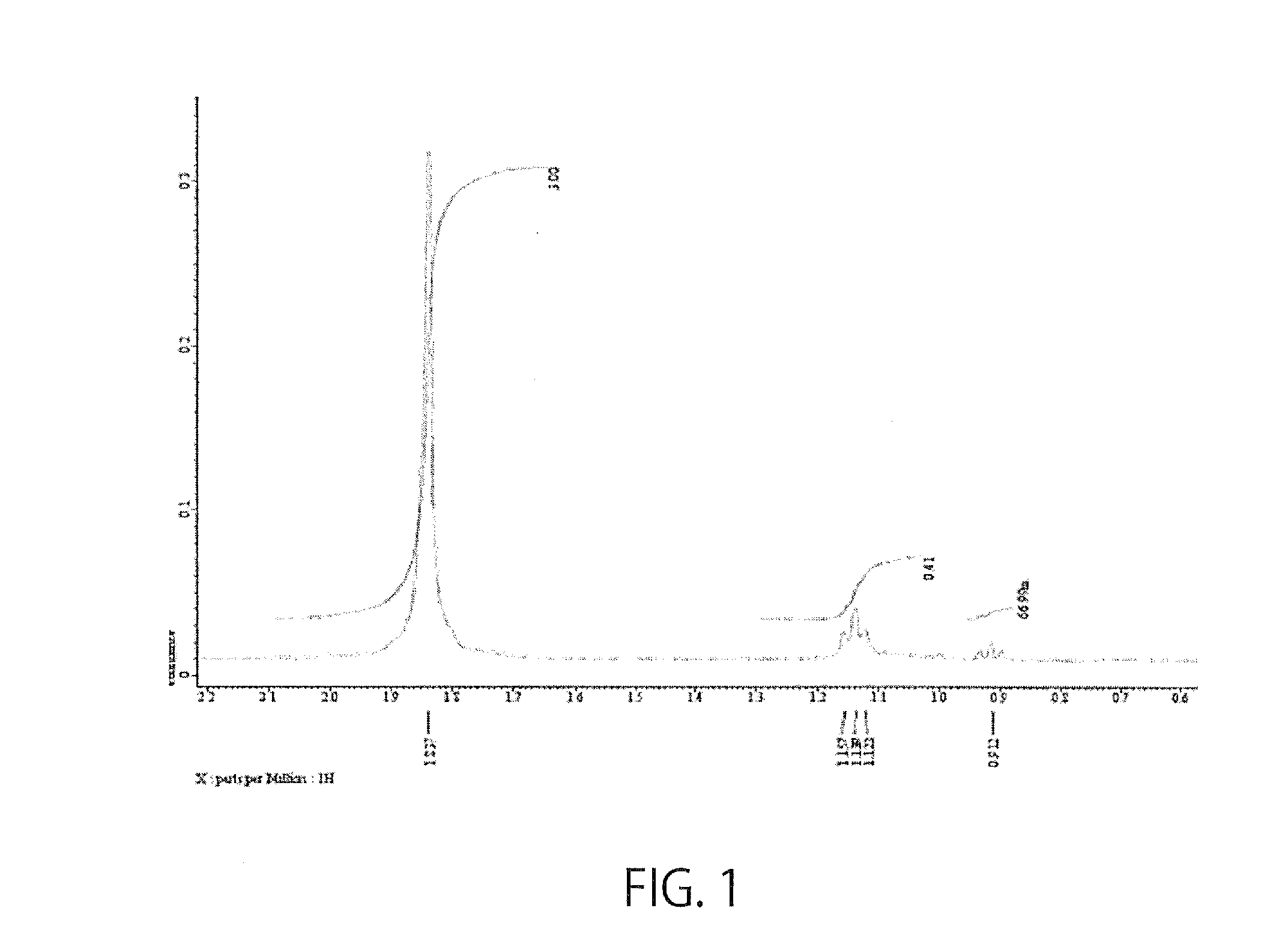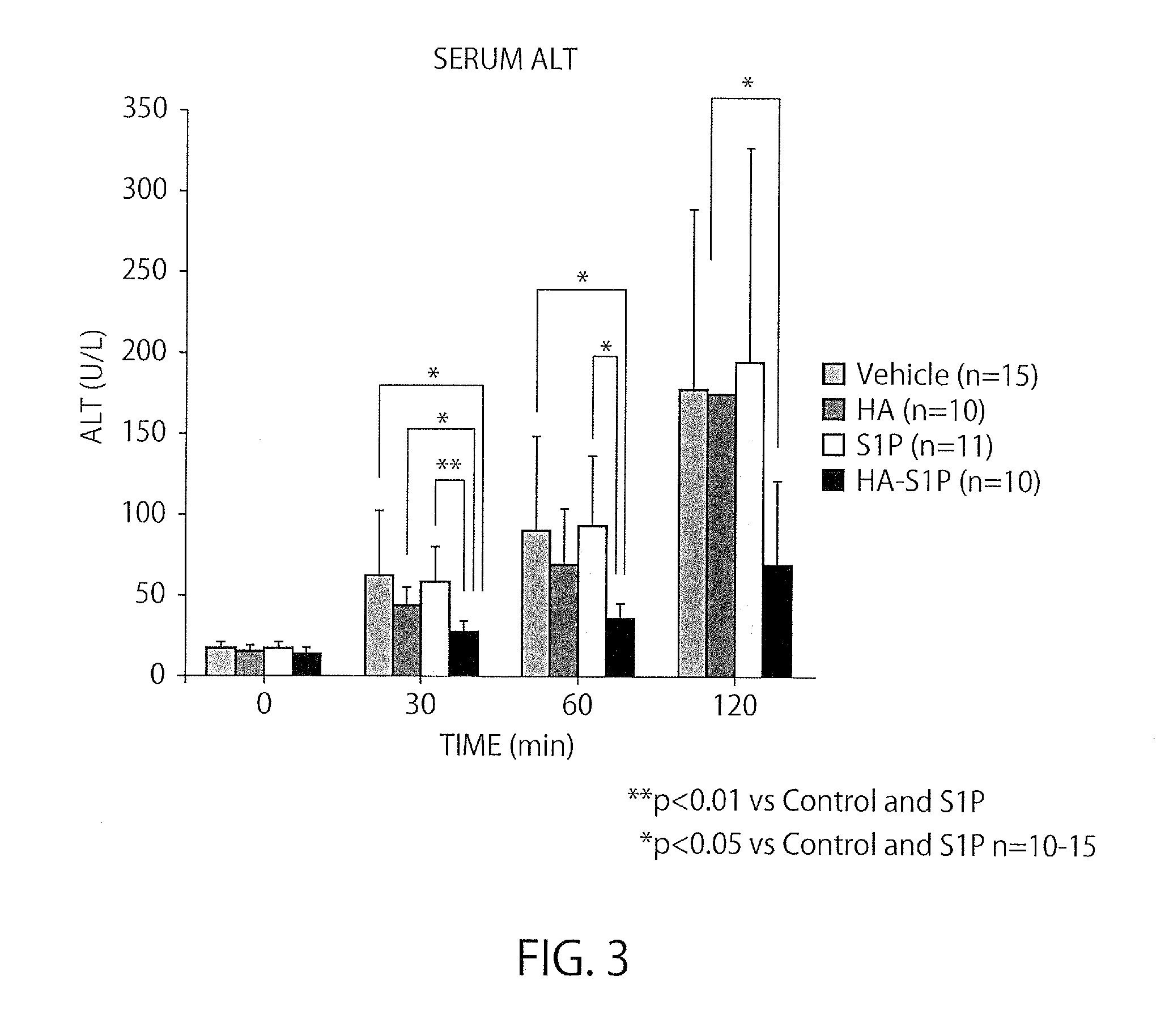Hyaluronic acid modified by sphingosine-1-phosphoric acid
a technology of sphingosine and hyaluronic acid, which is applied in the direction of surgical drugs, drug compositions, cardiovascular disorders, etc., can solve the problems that s1p itself cannot be used for the prevention and/or treatment of hepatic ischemia, and cannot solve the compound function, etc., to achieve the effect of inhibiting apoptosis, high efficiency, and high efficiency
- Summary
- Abstract
- Description
- Claims
- Application Information
AI Technical Summary
Benefits of technology
Problems solved by technology
Method used
Image
Examples
example 1
Synthesis of HA-S1P
[0042]To 5 ml of hyaluronic acid (2 mg / ml, one with a molecular weight of 600,000 or one with a molecular weight of 8,000), 95.85 μl of EDC (100 mg / ml) and 57.535 μl of NHS (100 mg / ml) were added, followed by thorough mixing. To the resulting mixture, 67.378 μl of S1P (25 mg / ml) was added, followed by stirring at 55° C., and reactions were allowed to proceed for 24 hours. Then, EDC, NHS, and unbound S1P were removed by dialysis. The introduction of S1P was confirmed by the presence of a peak near 1.15 ppm by measuring NMR (FIG. 1). The amount of S1P bound to the carboxylic acid of the hyaluronic acid accounted for 13.5 to 40%.
example 2
(1) Method
Animals
[0043]Male Sprague-Dawley (hereinbelow, SD) rats, 200 to 250 g, were obtained from CLEA Japan, Inc. (Tokyo, Japan). Four groups of SD rats were studied.
[0044]A study was conducted for a methanol-administration group, where methanol was the solvent for S1P (the content of administration:methanol (50 μl)+3% BSA (150 μl), 200 μl in total), a HA-administration group (the content of administration: 8 kDa HA dissolved in methanol:ultrapure water=1:3 at 0.32564 g / l, 200 μl in total), an S1P-administration group (the content of administration: 100 μg / kg in terms of the dose of S1P, S1P (50 μl)+3% BSA (150 μl), 200 μl in total), a HA-S1P-administration group (the content of administration: 100 μg / kg in terms of the dose of S1P, the HA-S1P formulation prepared at Hokkaido University was dissolved in methanol:ultrapure water=1:3 at 0.358 g / l, 200 μl in total).
[0045]All the procedures used in the animal experiments were in accordance with the standards set forth in a guideline ...
example 3
Confirmation of the Accumulation of S1P in the Liver by Western Blot
[0058]The expression of S1P in the liver tissues was confirmed by Western blot in accordance with the following method.
[0059]The rat liver tissues stored at −80° C. were homogenized in a buffer prepared from various reagents (150 mmol / L NaCl, 50 mM Tris-Cl, 1% NP-40, and a protease inhibitor). The resulting samples were centrifuged and the supernatants were collected for analysis. The samples thus obtained were separated using 10% SDS-PAGE gel and transferred to nitrocellulose membranes (Millipore, Bedford, Mass.). As the primary antibody, Anti-S1P antibody (ab140592) (1:1000, rabbit polyclonal, Abcam, Cambridge, UK) was used. As the secondary antibody, Anti-rabbit IgG, HRP-linked antibody (#7074S) (1:1000, Cell Signalling Technology, Beverley, Mass., USA) was used.
[0060]The results are shown in FIG. 9. The expression of S1P was higher in the HA-S1P sample than in the S1P only sample, suggesting that more specific a...
PUM
 Login to View More
Login to View More Abstract
Description
Claims
Application Information
 Login to View More
Login to View More - R&D
- Intellectual Property
- Life Sciences
- Materials
- Tech Scout
- Unparalleled Data Quality
- Higher Quality Content
- 60% Fewer Hallucinations
Browse by: Latest US Patents, China's latest patents, Technical Efficacy Thesaurus, Application Domain, Technology Topic, Popular Technical Reports.
© 2025 PatSnap. All rights reserved.Legal|Privacy policy|Modern Slavery Act Transparency Statement|Sitemap|About US| Contact US: help@patsnap.com



